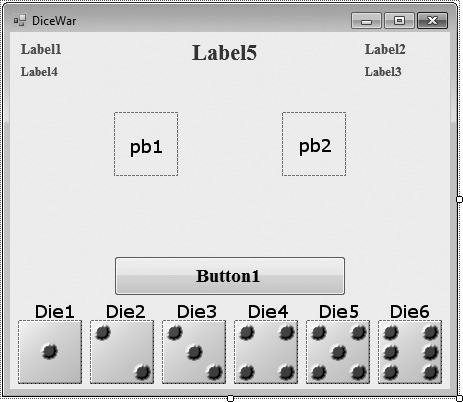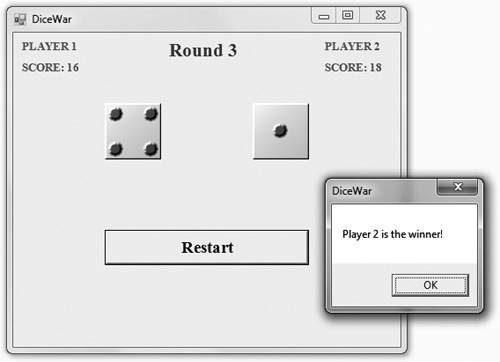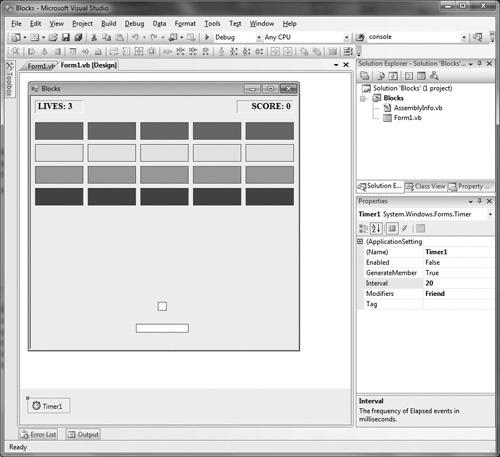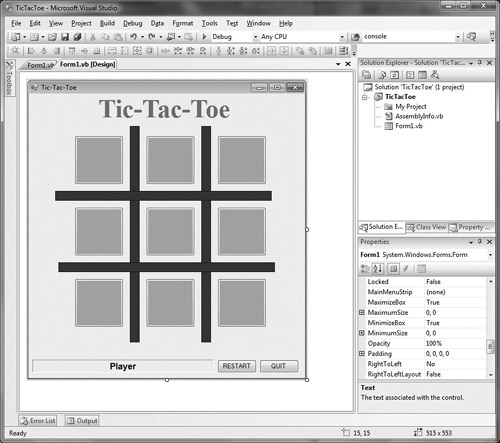This is a hands-on chapter to explore forms and controls in more detail in Visual Basic. While the previous chapter was primarily a language reference, this one will lead directly into the graphics programming coming up in the next chapter. These are important topics that should be studied in order, especially if you are new to Basic or game programming.
Here’s what we’ll cover in this chapter:
Our first example game in this chapter is Dice War, a game that simulates rolling of dice between two players and comparing scores—sort of a dice version of card-based War. There are three rounds during which the score of each player is accumulated, with the winner announced at the end of the third round. I have some personal affection for this game. Although simple in concept, it is a lot of fun and can be a programming challenge. I wrote my first Dice War game on my cousin’s Commodore PET back in the 1980s and it was stored on cassette tape. Sadly, the computer and its tapes are long gone. A year later, I re-created the game on an Apple IIgs in high school computer class—when the class was supposed to be learning about arrays or something, I’d finish the work quickly and then crank out my own game code in the lab. Back then, the dice had to be drawn with vector graphics, but in Visual Basic, we can use a PictureBox control and a bitmap for each of the six sides of the die. Figure 3.1 shows the images—what do you think, not bad for programmer art? I made each die side in GIMP with just rectangle and circle bevels and two-tone fills.
Hint
When a control such as PictureBox has a bitmap loaded via its Image property, that bitmap is stored in the form as a resource and the original bitmap file is no longer needed. Thus, it’s possible to store all game art on a form in order to hide it from users, but the resulting exe file (and memory footprint) will be much larger.
Figure 3.2 shows the control layout on the Dice War form with all of the properties already set, which you may use as a reference when creating the form yourself. Note the Timer1 control in the hidden controls section of the form editor (below the form).
Trick
To make a PictureBox control resize itself to match the loaded Image, set its SizeMode property to AutoSize.
Figure 3.3 shows the form with named controls. For the Die1..Die6 PictureBox controls, there are bitmap files for the die face images available in the project folder. Just choose a bitmap file via the Image property and it will be loaded.
The following global variables are needed by the game, and should be located just below the “Windows Form Designer generated code” section.
Dim Player As Integer = 1 Dim Round As Integer = 1 Dim Rolll As Integer = 1 Dim Rol 12 As Integer = 3 Dim Rolls As Integer Dim Score1 As Integer Dim Score2 As Integer Dim rand As Random
While building a game with Visual Basic, it’s common to double-click some controls to have the function for the default event generated. I will present the source code in the most likely order that you’ll need it as we go along. For instance, double-clicking the form itself generates the Form1_Load function.
Private Sub Form1_Load(ByVal sender As System.Object, _
ByVal e As System.EventArgs) Handles MyBase.Load
REM initialize the random number generator
rand = New Random()
REM draw initial dice images
pb1.Image = Die6.Image
pb2.Image = Die6.Image
End Sub
Now we will go over the code for the Button1 control, which will change depending on the state of the game—which player is rolling, etc. The Text property determines what happens when the button is clicked, causing either a game restart or a roll of the dice. The actual rolling animation is handled by the Timer1 event.
Private Sub Button1_Click(ByVal sender As System.Object, _
ByVal e As System.EventArgs) Handles Button1.Click
REM this event handles Restart as well as Roll
If Button1.Text = "Restart" Then
RestartGame()
Else
REM disable the Roll button
Button1.Enabled = False
REM start the rolling dice
Timer1.Enabled = True
End If
End Sub
Now, if you double-click the Timer1 control below the form, the default event for Timer is added to the source code in the same manner for visible form controls.
Private Sub Timer1_Tick(ByVal sender As System.Object, _
ByVal e As System.EventArgs) Handles Timer1.Tick
REM roll both dice
RollDie1()
RollDie2()
REM increment the roll counter
Rolls += 1
REM stop after 30 rolls (3 seconds)
If RollOver() Then
REM reset roll counter
Rolls = 0
REM disable the rolling dice
Timer1.Enabled = False
REM disable the Roll button
Button1.Enabled = True
REM display the dice roll for this player
DisplayRoll(Player)
REM check for game over
If GameOver() Then
Button1.Text = "Restart"
ShowWinner()
Else
REM not end of game, go to the next round
Label5.Text = "Round " & Round
End If
End If
End Sub
That’s the end of the control event functions, so now we can go over the helper functions called by the events. RestartGame() is called by Button1_Click at startup and whenever a game has ended (after three rounds). RollDie1() and RollDie2() are called by Timer1_Tick to get a random number (1 to 6) for each of the two dice—and this number is then used to draw the appropriate die image.
Private Sub RestartGame()
REM reset the game settings
Button1.Text = "Player 1 - Roll"
Score1 = 0
Score2 = 0
Label4.Text = "SCORE: " & Score1
Label3.Text = "SCORE: " & Score2
Round = 1
Label5.Text = "Round " & Round
pb1.Image = Die6.Image
pb2.Image = Die6.Image
End Sub
Private Sub RollDie1()
REM generate random roll for die 1
Roll1 = rand.Next(1, 6)
REM display the corresponding image (die 1-6)
Select Case Roll1
Case 1
pb1.Image = Die1.Image
Case 2
pb1.Image = Die2.Image
Case 3
pb1.Image = Die3.Image
Case 4
pb1.Image = Die4.Image
Case 5
pb1.Image = Die5.Image
Case 6
pb1.Image = Die6.Image
End Select
End Sub
Private Sub RollDie2()
REM generate random roll for die 2
Roll2 = rand.Next(1, 6)
REM display the corresponding image (die 1-6)
Select Case Roll2
Case 1
pb2.Image = Die1.Image
Case 2
pb2.Image = Die2.Image
Case 3
pb2.Image = Die3.Image
Case 4
pb2.Image = Die4.Image
Case 5
pb2.Image = Die5.Image
Case 6
pb2.Image = Die6.Image
End Select
End Sub
The RollOver() function is called by Timer1_Tick() to determine when it’s time to stop rolling the dice and display the results. It’s a small helper function that cleans up the code a bit. DisplayRoll() is called at the end of the dice rolling animation to notify the player of the result.
Private Function RollOver() As Boolean
If Rolls > 30 Then
RollOver = True
Else
RollOver = False
End If
End Function
Private Sub DisplayRoll(ByVal PlayerNum As Integer)
REM display total roll message depending on player
Select Case PlayerNum
Case 1
REM give player 1's score
MsgBox("Player 1, you rolled a " & CInt(Roll1 + Roll2) & ".")
Score1 += Roll1 + Roll2
Label4.Text = "SCORE: " & Score1
REM reset for player 2
Button1.Text = "Player 2 - Roll"
Player = 2
Case 2
REM give player 2's score
MsgBox("Player 2, you rolled a " & CInt(Roll1 + Roll2) & ".")
Score2 += Roll1 + Roll2
Label3.Text = "SCORE: " & Score2
REM reset for player 1
Button1.Text = "Player 1 - Roll"
Player = 1
REM player 2 marks end of each round
Round += 1
Case Else
MsgBox("PlayerNum is invalid")
End Select
End Sub
Finally, GameOver() is a helper that just determines when the third round has ended, while ShowWinner() displays the final results of the dice battle.
Private Function GameOver() As Boolean
If Round > 3 Then
GameOver = True
Else
GameOver = False
End If
End Function
Private Sub ShowWinner()
REM display the winner message
If Score1 = Score2 Then
MsgBox("This game is a draw!")
ElseIf Score1 > Score2 Then
MsgBox("Player 1 is the winner!")
ElseIf Score2 > Score1 Then
MsgBox("Player 2 is the winner!")
End If
End Sub
Figure 3.4 shows the conclusion to a three-round game of Dice War, with player 2 winning 18 to 16! Do you know what would make this game even more interesting? How about a single-player mode against the computer?
It’s time to ratchet up the difficulty level a few notches! The last project was fun but still just a turn-based game. There’s nothing quite like a real-time game to really experience exciting gameplay, because that requires a constant vigil over the controls and coordination without pause. It’s a totally different experience when you go real-time! The game we’ll create now is a simple version of the classic Atari Breakout ball-and-paddle game, which is really just a step above Pong, but a good example of a real-time game.
Figure 3.5 shows the layout of the Block Buster form. There are two labels at the top, Label1 to display the lives, and Label2 to display the score. There are four rows of colored blocks that are simply PictureBox controls with their BackColor property set to a color. You may use any color you wish for the blocks, so go ahead and design them however you want. The important thing (as far as the source code goes) is the name of the blocks. They are named Block1 to Block20, arranged in four rows and five columns. As long as there are 20 blocks with their names intact, the source code will work with the blocks, so you can move them around if you wish. This game affords some design aspects if we want to take advantage of it!
Ball is another PictureBox control resized to 16x16 with a BackColor of White. The ball moves at a constant X,Y velocity until it hits the edge of the form or strikes the paddle or one of the blocks, at which point it changes direction. Likewise, Paddle is a PictureBox with a size of 96 × 24, and it moves left and right with the mouse cursor—so the game is entirely mouse controlled (see the Form1_MouseMove event).
We’ll go over the source code for the Block Buster game in the most common event order, starting with Form1_Load. Since this is a real-time game with constant movement, a timer is used to keep things moving.
Dim intSpeedX As Integer = 2
Dim intSpeedY As Integer = -2
Dim intScore As Integer
Dim intLives As Integer = 3
Dim intAllGone As Integer
Private Sub Form1_Load(ByVal sender As System.Object, _
ByVal e As System.EventArgs) Handles MyBase.Load
Timer1.Interval = 20
Timer1.Enabled = True
End Sub
Next up is the Timer1_Tick function, which is called every time there is a timer tick. Since it was set to an Interval of 20, the timer will fire an event every 20 milliseconds (which is about 50 frames per second—or 50 Hz). A lot is happening in the timer function—in fact, all of the logic of the game happens here, including movement of the ball and checking for collisions. There are fewer comments this time; can you figure out what each portion of code is doing without comments?
Private Sub Timer1_Tick(ByVal sender As System.Object, _
ByVal e As System.EventArgs) Handles Timer1.Tick
AllGone = 0
CheckCollisions()
If AllGone = 1 Then
Timer1.Enabled = False
MsgBox("You finished the game!", , "CONGRATULATIONS")
End If
BallX += SpeedX
If BallX < 3 Or BallX + Ball.Width > Me.Width - 5 Then
SpeedX = -SpeedX
End If
BallY += SpeedY
If BallY < 3 Then
SpeedY = -SpeedY
End If
If BallY + Ball.Height > Me.Height - 5 Then
Timer1.Enabled = False
UpdateLives()
BallX = 232
BallY = 376
SpeedX = 2
SpeedY = -2
If Lives < 1 Then
MsgBox("You have lost the game.", , "OH NO!")
Else
MsgBox("You missed!", , "OH NO")
Timer1.Enabled = True
End If
End If
End Sub
The Form1_MouseMove() function responds to mouse movement over the form, so we can use this to move the paddle left or right based on the mouse’s position.
Private Sub Form1_MouseMove(ByVal sender As Object, _
ByVal e As System.Windows.Forms.MouseEventArgs) Handles MyBase.MouseMove
Paddle.Left = e.X - Paddle.Width 2
End Sub
Since the ball (actually a small PictureBox) is smaller than the paddle and the blocks, we can perform simple collision detection to see if the ball is hitting anything. The CheckCollision() function looks at the dimensions of the passed PictureBox control; taking that and the ball’s position on the form, it can be determined whether the ball is intersecting the passed PictureBox. Then it’s just a matter of removing the block and adding points to the player’s score.
Public Sub CheckCollisions()
CheckCollision(Paddle, False)
CheckCollision(Block1)
CheckCollision(Block2)
CheckCollision(Block3)
CheckCollision(Block4)
CheckCollision(Block5)
CheckCollision(Block6)
CheckCollision(Block7)
CheckCollision(Block8)
CheckCollision(Block9)
CheckCollision(Block10)
CheckCollision(Block11)
CheckCollision(Block12)
CheckCollision(Block13)
CheckCollision(Block14)
CheckCollision(Block15)
CheckCollision(Block16)
CheckCollision(Block17)
CheckCollision(Block18)
CheckCollision(Block19)
CheckCollision(Block20)
End Sub
Public Sub CheckCollision(ByRef src As PictureBox, ByVal Hide As Boolean)
If src.Visible = True Then
If BallX > src.Location.X And _
BallX < src.Location.X + src.Size.Width And _
Ball.Location.Y > src.Location.Y And _
Ball.Location.Y < src.Location.Y + src.Size.Height Then
SpeedY = -SpeedY
UpdateScore()
If Hide Then
src.Visible = False
End If
End If
AllGone += 1
End If
End Sub
REM declare the overloaded version of CheckCollision
Public Sub CheckCollision(ByVal src As PictureBox)
REM call the original version
CheckCollision(src, True)
End Sub
Public Sub UpdateScore()
Score += 10
Label2.Text = "SCORE: " & Score
End Sub
Public Sub UpdateLives()
Lives -= 1
Label1.Text = "LIVES: " & Lives
End Sub
Now we can see how useful a property can be in the source code for a real game. Following are several properties to illustrate the convenience afforded by this fascinating programming feature. We can just as easily use global variables directly in our functions, but use of a property instead of just a global variable is cleaner and allows for more control, not to mention error handling.
Public Property BallX() As Integer
Get
Return Ball.Left
End Get
Set(ByVal Value As Integer)
Ball.Left = Value
End Set
End Property
Public Property BallY() As Integer
Get
Return Ball.Top
End Get
Set(ByVal Value As Integer)
Ball.Top = Value
End Set
End Property
Public Property Lives() As Integer
Get
Return intLives
End Get
Set(ByVal Value As Integer)
intLives = Value
End Set
End Property
Public Property SpeedX() As Integer
Get
Return intSpeedX
End Get
Set(ByVal Value As Integer)
intSpeedX = Value
End Set
End Property
Public Property SpeedY() As Integer
Get
Return intSpeedY
End Get
Set(ByVal Value As Integer)
intSpeedY = Value
End Set
End Property
Public Property Score() As Integer
Get
Return intScore
End Get
Set(ByVal Value As Integer)
intScore = Value
End Set
End Property
Public Property AllGone() As Integer
Get
Return intAllGone
End Get
Set(ByVal Value As Integer)
intAllGone = Value
End Set
End Property
Our last game example is a version of the classic game, Tic-Tac-Toe, also known as Naughts & Crosses. This game has a rudimentary playing board with blue Panel controls used as dividers for the nine squares, which are comprised of Button controls named Button1 to Button9. See Figure 3.6. There is no Timer control in this game because it is turn based. Create the form as shown with the nine buttons. The title control is Label1. The message control at the bottom (which displays game states such as the current player) is called Label2. The button labeled “Restart” is Button10. The button labeled “Quit” is Button11. That should be all that’s needed by the source code.
We are going to use a little trick to cut down on the number of event functions in this game. Instead of generating an event for every one of the nine button click events, we’re instead going to have them all use the same event function. This is done using the Property Events window (see Figure 3.7). Double-click the first button, Button1, to generate the first event. Then go back to the form and select the remaining eight gameplay buttons, Button2 to Button9, and set their click events to Button1_Click.
Here is the source code for Button1_Click, which handles click events for all nine gameplay buttons. Note that all nine buttons are listed after the Handles keyword in the event definition. Now, the source code in this function is a bit different from usual. Instead of referring directly to Button1, Button2, etc., we instead use sender as the control. Since this function handles click events for only the controls listed, we needn’t worry about any other controls generating this event and can respond to the event in a generic way. For our gameplay purposes, the Text property of the button is set to Token (which will be either “X” or “O” depending on the current player). Then that button is disabled so it can’t be picked again, and CheckWinner() is called to test for three-in-a-row win conditions.
Private Sub Button1_Click(ByVal sender As System.Object, _
ByVal e As System.EventArgs) Handles Button1.Click, _
Button2.Click, Button3.Click, Button4.Click, Button5.Click,-
Button6.Click, Button7.Click, Button8.Click, Button9.Click
sender.Text = Token
sender.Enabled = False
CheckWinner()
End Sub
Let’s dig in to the rest of the source code now, first with two global variables and the Form1_Load function which calls RestartGame().
Dim Token As Char
Dim Player As Integer
Dim Winner As Boolean
Private Sub Form1_Load(ByVal sender As System.Object, _
ByVal e As System.EventArgs) Handles MyBase.Load
RestartGame()
End Sub
Next up are the two event handlers for the Restart and Quit buttons.
Private Sub Button10_Click(ByVal sender As System.Object, _
ByVal e As System.EventArgs) Handles Button10.Click
REM restart button
RestartGame()
End Sub
Private Sub Button11_Click(ByVal sender As System.Object, _
ByVal e As System.EventArgs) Handles Button11.Click
REM quit button
End
End Sub
The CheckWinner() function goes through the rows, columns, and diagonals looking for matching Xs or Os to find a winner (if there is one). The helper function TestThreeInARow() performs the test on three squares at a time to see if there is a match. If no winner is found, then play continues to the next player. It does this by looking at the Text property of each Button control and simply checks whether the three are equal to each other, which means the player has chosen those three in a row.
Private Sub CheckWinner()
REM check rows
TestThreeInARow(Button1, Button2, Button3)
TestThreeInARow(Button4, Button5, Button6)
TestThreeInARow(Button7, Button8, Button9)
REM check columns
TestThreeInARow(Button1, Button4, Button7)
TestThreeInARow(Button2, Button5, Button8)
TestThreeInARow(Button3, Button6, Button9)
REM check diagonals
TestThreeInARow(Button1, Button5, Button9)
TestThreeInARow(Button3, Button5, Button7)
If Not Winner Then
NextPlayer()
End If
End Sub
Private Sub TestThreeInARow(ByRef one As Button, _
ByRef two As Button, ByRef three As Button)
If one.Text.Length + two.Text.Length + three.Text.Length > 0 _
And one.Text = two.Text And two.Text = three.Text Then
one.BackColor = Color.Yellow
two.BackColor = Color.Yellow
three.BackColor = Color.Yellow
Winner = True
DisplayWinner()
End If
End Sub
Two helper functions help to keep the code clean and tidy: NextPlayer() goes to the next player by setting the Token and Player variables as appropriate; DisplayWinner() disables all of the buttons (to prevent any further moves) and displays the winner using Label2 on the bottom of the form.
Private Sub NextPlayer()
If Player = 1 Then
Token = "X"
Player = 2
ElseIf Player = 2 Then
Token = "O"
Player = 1
End If
Label2.Text = "Player " & Player & " : '" & Token & "'"
End Sub
Private Sub DisplayWinner()
REM display winner message
Label2.Text = "Player '" & Token & "' is the winner!"
REM disable all the buttons
Button1.Enabled = False
Button2.Enabled = False
Button3.Enabled = False
Button4.Enabled = False
Button5.Enabled = False
Button6.Enabled = False
Button7.Enabled = False
Button8.Enabled = False
Button9.Enabled = False
End Sub
Finally, RestartGame() resets the game’s state, gameplay variables, and controls to the initial setting so the game can be played again.
Private Sub RestartGame()
REM re-enable the buttons
Button1.Enabled = True
Button2.Enabled = True
Button3.Enabled = True
Button4.Enabled = True
Button5.Enabled = True
Button6.Enabled = True
Button7.Enabled = True
Button8.Enabled = True
Button9.Enabled = True
REM clear the button labels
Button1.Text = ""
Button2.Text = ""
Button3.Text = ""
Button4.Text = ""
Button5.Text = ""
Button6.Text = ""
Button7.Text = ""
Button8.Text = ""
Button9.Text = ""
REM set the button background colors
Button1.BackColor = Color.LimeGreen
Button2.BackColor = Color.LimeGreen
Button3.BackColor = Color.LimeGreen
Button4.BackColor = Color.LimeGreen
Button5.BackColor = Color.LimeGreen
Button6.BackColor = Color.LimeGreen
Button7.BackColor = Color.LimeGreen
Button8.BackColor = Color.LimeGreen
Button9.BackColor = Color.LimeGreen
REM set up the new game
Winner = False
Player = 2
Token = "O"
NextPlayer()
End Sub
Figure 3.8 shows the Tic-Tac-Toe game running with the first column of Xs giving victory to the X player!
It’s time to level up after learning so many new skills with Visual Basic forms and controls! In this chapter you have studied the intricacies of control programming (and a few special tricks) while building three complete games. As you were working on the games, I’m sure you saw some areas for improvement. After all, these games are kept on the simple side so they are easy to understand. But you are under no such limitation! So, why don’t you see if you can add some new gameplay capabilities to these games to make them more interesting, and ultimately, more playable?







